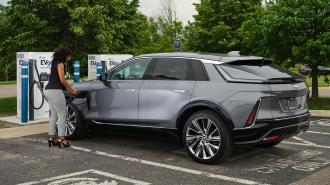General Motors (GM) has unveiled a plan to get more people behind the wheels of electric vehicles (EVs) — and it doesn’t involve a new car.
The company is building a coast-to-coast EV charging network along US highways, helping grow the infrastructure needed to make drivers feel confident buying EVs.
The challenge: Transportation pumps more greenhouse gasses into the atmosphere than any other sector in the US, so transitioning to EVs is key to fighting climate change — yet EVs accounted for less than 3% of America’s new car sales in 2021.
The most common reasons people give for not buying EVs involve charging: they don’t want to deal with long charge times, or they’re afraid they’ll be stranded somewhere with a dead battery because they couldn’t find a charging station when they needed one.
GM’s new EV charging network will include 2,000 charging stalls at up to 500 locations.
What’s new? GM is already working with EV charging company EVgo on a plan to install 3,250 charging stalls in major metro areas by 2025, and it recently launched a program to install up to 40,000 stalls at North American dealerships.
Now, it’s collaborating with Pilot Company to create a coast-to-coast EV charging network it believes will make it easier for EV drivers to find a charger any time they need one.
“We are committed to an all-electric, zero-emissions future, and ensuring that the right charging infrastructure is in place is a key piece of the puzzle,” said GM CEO Mary Barra.
The details: The new EV charging network will include 2,000 charging stalls, installed, operated, and maintained by EVgo. These chargers will be accessible to all EV brands, though drivers of GM vehicles will receive special benefits.
The network will include 350-kilowatt DC fast chargers, which can add 150 miles of range to an EV in just 8-12 minutes. That’s faster than most EVs can actually handle, but the chargers will adjust to whatever the vehicle’s max charging speed is.
“The missing piece in the larger picture of public charging is along highway corridors.”
Travis Hester
The chargers will be located at up to 500 Pilot and Flying J travel centers near major highways — the goal is to have at least one stall available every 50 miles, with the first chargers coming online in 2023.
“The missing piece in the larger picture of public charging is along highway corridors … They form a vital network, which moves vehicles and people throughout the country,” said GM’s chief EV officer Travis Hester.
The big picture: The US has about 123,000 public charging stalls, according to the Department of Energy, so GM’s new EV charging network will increase the total by less than 2%.
However, by locating its stalls near major highways, the company could make longer-distance EV trips less daunting — and perhaps give drivers the confidence they need to make the switch to electric.
We’d love to hear from you! If you have a comment about this article or if you have a tip for a future Freethink story, please email us at [email protected].






